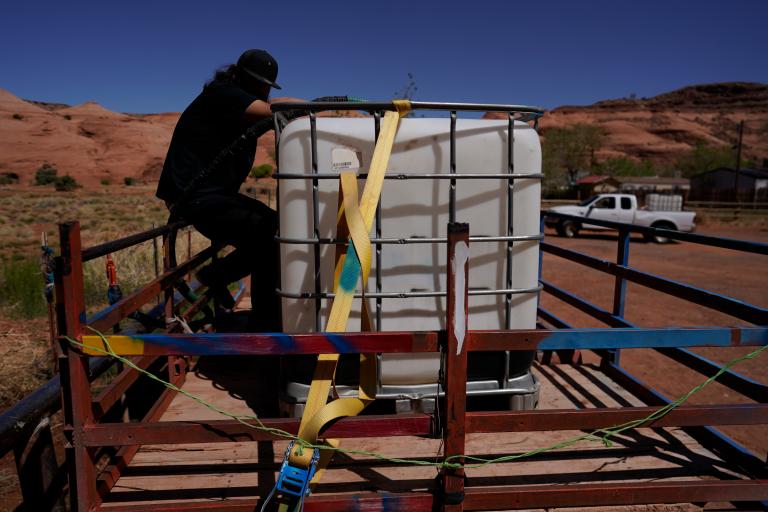Fabio Luis de Oliviera Rosa is a fellow with Ashoka Brazil. An economist and lawyer, he has developed low-cost rural electrification models to improve quality of life for the rural poor and to slow urban migration.

Monday, 6 Nov 2000
PORTO ALEGRE, Brazil
At IDEAAS, the Brazilian NGO that I started, we are working in rural areas to develop and improve programs that simultaneously eliminate poverty, promote sustainable development, and conserve the environment. To this end, we combine technology with appropriate actions and policies. Our projects are highly integrated, simultaneously utilizing knowledge from agronomy, electrical engineering, sociology, banking, politics, economics, the environmental field, and organizational administration. It’s a big challenge because we need to go further, from the multi-disciplinary to the trans-disciplinary.
In the different areas of Brazil where we work — from the pampas here in the extreme south, to the Amazon in the north, passing through Cerrado in the center, and the arid and semiarid northeast — the challenges are the same, though the symptoms vary: excluded populations, children with miserable childhoods, degraded environments, threatened biodiversity, and people living as they did in the 18th and 19th centuries, without electricity or communications, lacking both adequate public policies and a systematic vision for sustainable development. In essence, there are many, many deficiencies.
At the same time, in all these places, one finds a humble and moving testimony from the brave Brazilian people. People are interested in improving their lives and the lives of their children, in conserving the environment, in dreaming of and fighting for a better and brighter future. In general, everyone has a notion of their problems, and these are spoken of with a touching sincerity.
A great conscience exists among the people that gives importance to living without destroying the environment: relating to it, understanding it, harvesting the fruits of its plenty with care, and guaranteeing its future survival. It is possible to involve people in a movement for both human and environmental well-being. By working with the people, it is possible to think about constructing a better future.
In the next four days, I will be working with you all, as is the daily work of someone who thinks about constructing a positive future. We will begin in Bahia, where I have a partnership with another Ashoka Fellow working to develop rural solar photovoltaic electrification in arid zones with poor populations.
In the interior state of Rio de Janeiro, we will visit another project, where a hacienda has managed to address its environmental, social, and economic challenges with a system of organic management, a stance for conservation of the Atlantic Forest, and a successful business.
Afterwards, we will continue south to Parana State, to visit a project in partnership with yet another Ashoka Fellow. Here, we are uniting environmental conservation and models of sustainable development in a project to fight global warming.
And finally, we will return to the city of Porto Alegre, here in the extreme south of Brazil, where the pampas begin. You will learn about two projects that we are developing with IDEAAS: a big rural solar electrification project and a project to reverse the deserts that are emerging in the Brazilian pampas due to human activity.
I’ll see you tomorrow, when we begin our journey.
Tuesday, 7 Nov 2000
PORTO ALEGRE, Brazil
Today I think I’ll tell you a story that began a long time ago. This is an old story, with a happy end. But the story is not over yet. It is a case where the replay of the happy ending continues ceaselessly.
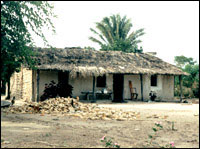
Living beyond the grid in Bahia.
Photo: Lyon Press.
The question I began this story with was: How could solar energy and electric fences help people who are trying to survive in the semi-arid climate of Bahia, a state in eastern Brazil?
It was the beginning of 1992 when I told Cindy Lessa, the Ashoka Brazil director at the time, about my new idea to use solar energy and electric fences to promote rural electrification and increase rural farm family incomes.
The idea was very simple. It was (and it still continues to be) evident that the electricity network would not reach this vast Brazilian territory in the near future (and probably not even in the far future). With solar energy, it would be possible to provide electric power to 25 million Brazilians excluded from the world of electricity and the Internet. Furthermore, if these small farmers had electric power, it would be possible to help them increase their family income with a model of organic sustainable animal rearing, called ecological grazing management.
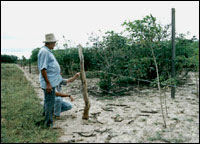
Building an electric fence.
Photo: Lyon Press.
After listening to my plan, Cindy said she wanted to introduce me to another Ashoka fellow, Ismael Ferreira of Bahia. It was the year of the Rio Summit, and during the event Ashoka organized a workshop with the fellows who worked on the environment and sustainable development. Cindy introduced us, and I met with Ismael for about two hours. I presented to him the idea of solar energy and the use of electric fences in Bahia. This was of interest to him, since he was the leader of APAEB, an association for community development in the semi-arid region of Bahia, where residents did not have electric power and faced great difficulty obtaining enough milk and meat for their kids.
The environment did not allow cattle raising, so the solution was to use goats. But there was a problem: To raise goats it was necessary to build fences, which were too expensive. The solution? Electric fences. They decreased the cost of fencing by up to 80 percent, and made it possible to raise goats. The lack of electric power for the fences would be eliminated with the use of solar panels. I then proposed for Ismael to use slightly larger solar panels so that houses could also have electric power. Ismael accepted.
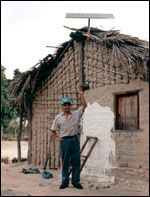
A bright idea: Solar cells.
Photo: Lyon Press.
Ismael and his staff came for training here in Porto Alegre. They then returned to Bahia and started a very successful project that has become a model throughout Brazil. Currently APAEB has a well-established project of solar rural electrification and the use of electric fences, with more than 500 systems installed. After more than eight years, Ismael and I still stay in touch and work together. This is an example of the kinds of partnerships and projects promoted by Ashoka.
Now people have electric power and comfort in their homes. Solar energy and electric fences also began a new process of development in the region because family incomes can be increased by raising goats. This is just one case of how the use of appropriate technology and social entrepreneurship can promote sustainable development, even in an inhospitable environment.
A story with a happy ending that has not finished, and continues to bring comfort to families throughout Brazil.
Wednesday, 8 Nov 2000
RIO DE JANEIRO, Brazil
I arrive at the Tom
Jobim Airport in Rio de Janeiro very early. From Rio, I drive two hours to a farm in the countryside, which I visit once a month.
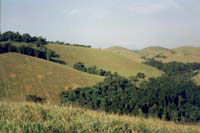
Degraded pasture in the Rio de Janeiro state.
Here, I’m working on a farm that has survived the Brazilian coffee age. Three hundred years ago, a forest called Mata Atlantica used to cover this entire area. Then it was cut down to make room for coffee plantations in the 19th century. About 30 years ago, the coffee plantations were replaced by pasture, which degraded as time passed. The results were poor. The animals raised on this land looked ugly, were skinny, and produced few calves each year. Today, the Mata Atlantica forest has begun to recover. Forest now covers about 50 percent of the total area of the farm I’m visiting, where the current owner values its preservation.
When I first visited this farm two years ago, it was very clear to me that I was talking to people who had serious and good intentions (and this is very important!), but who needed a new model to manage their farm. It was also clear to me that I was, once again, in contact with the last remnants of the so-called “green revolution,” which invariably led to cut-down forests, muddy rivers, eroded land, destroyed environment, bankrupt farms, and frustrated people.
So, we got to work.
Using our knowledge of plants and of animal physiology, we initiated a new model of management: Pasture areas are separated by electric-wire fences (which we made ourselves) powered by photovoltaic solar energy. The pastures are divided into small paddocks and animals are allowed to graze in each one for one day only. Then the paddock is left to rest for about 30 days in the wet season (summer) and 60 days in the dry season (winter) before the animals return.
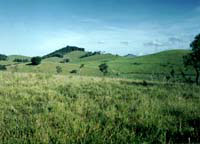
Healthy pasture after a year of restoration.
The pastures have time to rest from the grazing and can grow again. Every day, when the cows go to a new paddock, they find good and copious amounts of food. They are outdoors and feed themselves entirely from pastures (ruminants are the only animals that can transform straw into high-quality proteins), drink water whenever they want, and rest in the shade of big trees. They enjoy comfort and are not confined to feed lots (called animal concentration camps by Jose Lutzemberger).
The result of this work is that we can produce organic meat and milk without the use of grains or chemicals and without destroying the environment. The farm production increased by 100 percent in one year. Now, the outcomes are positive. The farmer is proud and has recovered his self-esteem. The soil is thoroughly covered with straw, leaves, and manure. Erosion is no longer a problem, not even when the rain comes in the tropical summer. The farm is alive again.
This model of sustainability can be replicated on other tropical and subtropical farms. From the start, we intended to develop a model on this farm that could be reproduced on a large scale by all the farmers in the region (I think replicability is an obsession of every Ashoka Fellow). For this process our NGO, IDEAAS, will establish a partnership with local NGOs.
Today, while I was in the field visiting the project, I felt once again the harmony of life and was sure that it is possible to live on our planet in peace with all our brothers: blue sky, clean water, green grasslands, content and well-fed animals. Peace and quiet are everywhere.
Far in the distance, the mountains are covered with the Mata Atlantica forest, and I can hear the birds singing and the small monkeys grunting. Once again, I am sure that it is possible, here on earth, to be near God.
Thursday, 9 Nov 2000
PARANA, Brazil
For the past six months I have been spending five days a month here in Parana, working with one of Brazil’s pioneers in carbon sequestration projects, my friend Clovis Borges (another Ashoka Fellow). Clovis is a founding member and the executive director of SPVS — Society for Wild Life Preservation and Environmental Education. This NGO, located in Curitiba in the state of Parana, is responsible for important work in the conservation of the largest contiguous area of the Atlantic Forest.
In partnership with The Nature Conservancy, last year SPVS began to establish protected forest reserves in the Guaraquecaba Bay region, as well as programs around the reserves that help the local community develop new income-generating opportunities that will not harm the forest. The electric company CSW (Central and South Western Company) and General Motors have invested in the project. The carbon credits from the reserves will be measured based on established conservation and management procedures.
About a year ago, Clovis told me about his project and a new challenge that he suddenly faced: Buffalo herders had occupied most of the area. The buffalo is a rural animal (and docile, if well cared for). During the “green revolution” of the 1970s, with the help of international funding, buffalo were thrown into the Atlantic Forest. Not only have the buffalo had a profoundly devastating effect on the forest, but the farmers have not even benefited from the program. The buffalo, loose in an inhospitable environment, without the benefit of animal husbandry expertise or appropriate fodder, were unable to produce sufficient offspring to make grazing lucrative.
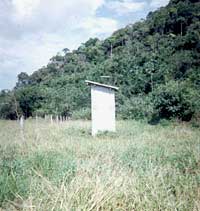
Solar powered electric fencing in action.
We were very close to a conflict between conservationists and farmers. Furthermore, the farmers were gradually growing poorer. I suggested a very simple idea: With the use of electric fences, we would remove the buffalo from the Atlantic Forest so that it could recover without the destructive impacts of the animals, and the buffalo would be limited to designated grazing land. We would develop techniques that would enable the recovery of the land, increase milk and meat production, and, finally, increase the farmers’ incomes.
Exactly one month ago, we started the first pilot project in this area and today I am back to follow up and see what has been happening. The farmers’ efforts show that, from the fifth day on, according to our measurements, production (and consequently income) has increased by 25 percent due to proper animal handling. Organic milk is produced and used to make buffalo mozzarella cheese. In addition, the animals have been removed from the forest reserves and SPVS has been replanting native trees in the devastated area. Soon, we will apply this model on a larger scale.
Tomorrow, I return home to Porto Alegre to take care of two big projects for IDEAAS. Ate la. See you there.
Friday, 10 Nov 2000
PORTO ALEGRE, Brazil
Today I am working on the last details of our business plan for the Social Entrepreneur Award, promoted by McKinsey and Ashoka. This award recognizes the development of financially sustainable and strategic business plans that can help take “citizen sector organizations” to a new level of success. Out of 187 entries, the plan devleoped by IDEAAS, an NGO I work with, is among the 10 finalists.
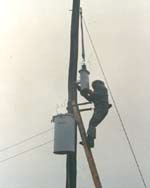
Bring power to the people.
We have been working on a new model to quickly bring electricity to the whole interior of Brazil. Because the majority of Brazilians without electric power live in very isolated rural areas without access
to the grid, we envision using photovoltaic cells to provide solar power. In Rio Grande do Sul alone, there are approximately 150,000 people isolated from the electric power networks, and it is well known that there are no plans to expand conventional electrical services to give them access. Besides, we can offer CDM — Clean Development Mechanism — credits, which will increase funding for IDEAAS.
This project, which we call “The Sun Shines for All,” has an initial phase of rural electrification and a second phase in which we help rural residents raise their incomes by increasing agricultural production, starting new businesses, and improving education, and in which we provide them with access to information technology, including the Internet. Without electric power, none of this would be possible.

Happy, organic cows.
We are also working on a “Save the Pampas” project in southern Brazil, where there are approximately 10 million hectares of pampas. In 1900, there were 3,000 hectares of desert in this region, but now there are an additional 30,000 hectares of desert created by the actions of people. To add flora and fauna to this dismal equation, approximately 150 species in the region are under threat of extinction. Our project here consists of an integrated plan for reforestation of desert areas, rural photovoltaic electrification to help keep farmers on their land, and a plan for optimization of grazing in the pampas. All these activities, besides providing direct benefits to the land, also generate CDM credits.
IDEAAS, through its staff, not only has the knowledge to implement models for sustainable development through sustainable projects, but also to manage the IDEAAS Funds, which guarantee the continuity of the projects. With the consolidation of the models we are implementing here in Rio Grande do Sul, Parana, Rio de Janeiro, Bahia, and other Brazilian states, and with the model of IDEAAS Fund ready for implementation, I hope that we will be able to launch a project that will rapidly reach the entire country through a network of social franchises. The goal is to use renewable energy to produce without destroying. The first steps have already been taken.
Nos vamos chegar la. We will get there.
This is my final contribution to Grist. I would like to thank you for reading my words this week. Please email me at ideaas@plug-in.com.br for additional information; I will be happy to answer your questions.
The story does not end here.


